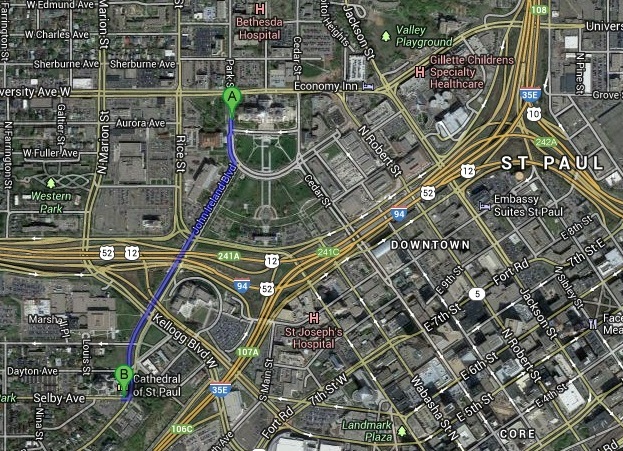If you look from a bird’s-eye view of the state capitol and zoom out to a six-block radius, you will notice that there are actually two large domed buildings near downtown St. Paul—each one serving a distinct purpose—separated by a stretch of intertwined urban freeway. This section of freeway is commonly identified as “Spaghetti Junction” (I think atheists should start calling it “Flying Spaghetti Monster Junction”), and it sharply symbolizes the importance of church and state separation.
.The domed building that is north of the I-94 spaghetti strand is the Minnesota state capitol and the domed building to the south of the I-94 spaghetti strand is the Cathedral of Saint Paul. The former is where the business of the government takes place and the latter is where the business of the church takes place.
The domed capitol is where laws are made and constitutional rights are preserved. It’s where bills are drafted, debated, and signed. It’s where the people’s elected representatives join together to serve the interests of our increasingly diverse statewide community, consisting of several theistic and nontheistic perspectives.
The domed church is where religious beliefs are established and prayer is demanded. It’s where the Bible is taught, rationalized, and praised. It’s where clergy and parishioners gather to serve the interests of their doctrine and their religious institution.
The domed capitol represents our nation’s celebrated secular American values—like liberty, justice, and the pursuit of happiness; whereas the domed church represents the church’s dogmatic values—like faith, submission, and lifelong celibacy for clergy.
The domed capitol falls under the purview of the United States Constitution, which makes no mention of God, and the domed church falls under the purview of the Bible, which makes several mentions of God.
Minnesota Atheists’ annual Day of Reason event was again held under the capitol dome as a way to remind our elected representatives as well as our pious neighbors that there is a good reason for these two separate domes. We wanted to remind them that injecting God-beliefs, Bible stories, dogma, and religious rituals into our public schools, public policy, courthouses, and military is not only disrespectful but unconstitutional.
If we are to truly be “One Nation Indivisible,” our government should respect the two separate domains and stick to the business of government—not the business of the church. Our elected lawmakers should encourage their constituents to think critically and to be good stewards of our shared community, instead of encouraging their constituents to pray and preserve sectarian rituals. Let the clergy lead their followers in prayer in one of their many houses of worship.
I remain hopeful that we are approaching an end to this government endorsement of religious rituals and religious indoctrination. According to several polls, the number of religious believers is on the decline while those who have no religious identity (The “Nones”) are increasing. It may not be too much longer until the number of participants at the Day of Reason outnumbers those participating in the Day of Prayer at the dome north of FSM Junction.


